This was published 3 years ago
How accessible is Melbourne for people with a disability?
When Lonely Planet described Federation Square as “not for everyone” the travel bible wasn’t referring to its love-it-or-loathe-it aesthetic.
It meant Melbourne’s premier civic space was literally not for everyone; for people in a wheelchair the uneven sandstone tiles in Federation Square can be difficult to traverse.
“There are accessible lifts and toilets, so it’s good in that respect,” says Martin Heng, the author of Accessible Melbourne, Lonely Planet’s guide for travellers with access needs.
“But the open square itself is pretty much a disaster for two reasons: first of all the gradient and secondly the cobblestones. It’s so disappointing.”
Heng, an inclusive travel expert and member of the Victorian Disability Advisory Council, has travelled the world in his wheelchair.
He says compared with other major cities in the world Melbourne – with its compact and relatively flat city centre – is reasonably accessible.
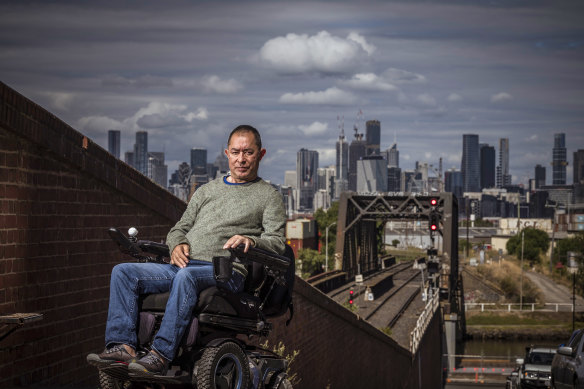
Lonely Planet author Martin Heng says Melbourne is reasonably accessible on a global scale.Credit: Chris Hopkins
Major tourist attractions and public transport – with the exception of many trams – are accessible and city intersections have audio pedestrian crossing signals and tactile paving for the vision impaired.
But the city is not always inclusive of the 17 per cent of Victorians, more than a million people, who have a disability.
When tennis star Dylan Alcott, a Melburnian, made history by becoming the first person with a visible disability to be named Australian of the Year last month, he immediately raised awareness about accessibility.
“I thought I was no chance and then I got here and I saw this really good-looking ramp and I thought, ‘I might have a chance here’,” he quipped in his acceptance speech.

Dylan Alcott after winning the 2021 Australian Open Quad Wheelchair Singles Title.Credit: Darrian Traynor
Alcott has famously crowd surfed in his wheelchair at music festivals and created Australia’s first accessible and fully inclusive music festival, AbilityFest.
He has pledged to use his platform as Australian of the Year to change perceptions “so people with disability, people like me, can get out there and live the lives that they deserve to live”.
People with a disability hope Alcott’s advocacy will lead to change.
“There are not many people who have done as much from an awareness point of view as Dylan,” says Ryan Smith, the creator of Free Wheel Weekends, a website aimed at providing fellow wheelchair users with the lowdown on accessibility.
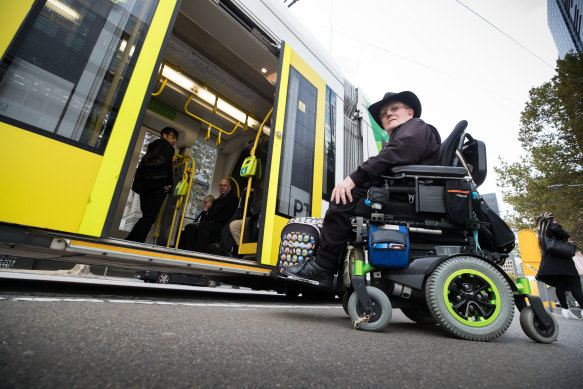
Wheelchair users have been complaining about tram access for years.Credit: Jason South
“I’ll be interested to see how he uses that platform to benefit people with all sorts of disability, including invisible disability.”
In Melbourne, one of the running sores is the inaccessibility of the tram network for people in a wheelchair.
Just 27 per cent of the city’s 1700 tram stops are level-access despite federal Disability Standards for Accessible Public Transport 2002 requiring they all be accessible by the end of this year.
A 2020 Victorian Auditor General report said the Department of Transport “cannot comply” with this target, putting the government at risk of breaching discrimination laws by failing to stop and remove discriminatory practices.
“Non-compliance poses a financial risk for the state due to possible legal rulings against it for not meeting legislative requirements,” the report said.
Five people with a range of disabilities have already launched legal action under Victoria’s Equal Opportunity Act, saying it is unacceptable that disability standards created two decades ago are still so far from being met.
The state government told The Age the federal standards are currently being reviewed, but improved accessibility remains its priority for current and future transport projects.
“There’s always more that can be done, and we are actively working with operators and the community to ensure every Victorian can safely get to where they need to go,” a spokesperson said.
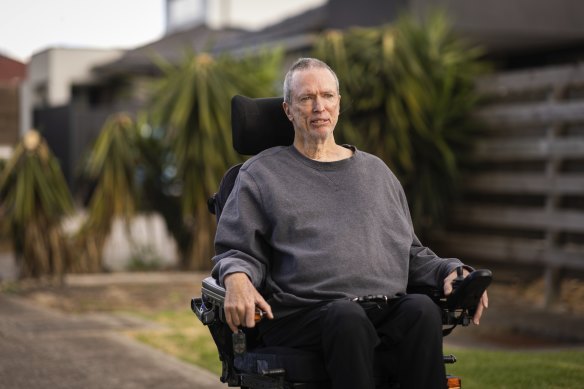
Ray Jordan has been stuck on a train when the driver forgot to attach a ramp to let him off.Credit: Paul Jeffers
All Metro railway stations are accessible via ramp or lifts except Heyington station in Toorak.
Ray Jordan is the administrator of the All Aboard network, which fights to eliminate the discrimination faced by people with disability on public transport.
Like many wheelchair users, he has been left stranded at a station or stuck on a train when the driver forgot to get out and place a ramp between the station platform and train floor.
“It was very frustrating,” Jordan says. “The ideal is perfectly level access where you don’t need to rely on a driver to put down a ramp, you just drive your wheelchair straight on the train. They can do it in Atlanta, they can do it in Perth, they can do it in a lot of places around the world.”
The City of Melbourne’s disability access plan pledges to work with transport groups to make transport more accessible.
It also says it will make sure access is part of its building plans, increase the number of changing places (accessible toilets with change tables and hoists for people with severe disabilities), make events more accessible, employ people with disability and distribute sunflower lanyards that indicate someone has a hidden disability.
“Accessibility will always be a key priority at the City of Melbourne, and we will continue listening to our community regarding any possible improvements that can be made,” says lord mayor Sally Capp.
The council provides an interactive CBD mobility map, documenting street gradients, accessible toilets, mobility recharging points and disabled parking.
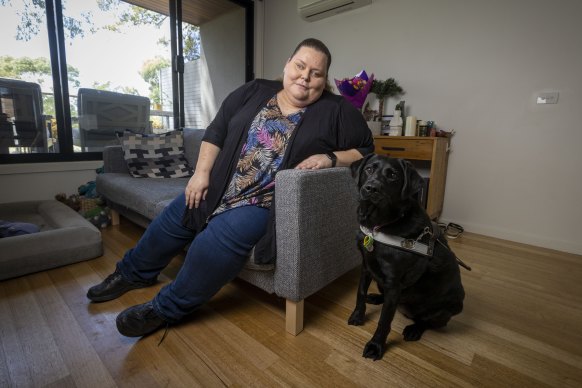
Kelly Schulz says taxis will sometimes refuse to pick her up with her guide dog Velvet.Credit: Wayne Taylor
Virtual GPS beacons along Bourke and Swanston streets send audio messages about potential obstacles – such as construction work – to the phone app BlindSquare to help people with low vision or blindness navigate the city.
Kelly Schulz is an accessibility advisor, who has had a congenital vision impairment since birth.
“There are some great things in Melbourne that are not in other places, such as audible traffic lights and tactile street signage,” she says.
“In terms of navigating the streets themselves, Melbourne is not too bad, and it certainly helps having a Hoddle grid.”
However the rise in outdoor dining due to the pandemic had seen an increase in footpaths being cluttered with outdoor tables and chairs and menu and sanitiser stands, along with motorbikes and signage.
Schulz says the push to discourage cars from the CBD also made life difficult for people with disabilities.
“Because of the bike lanes that have been added there is no safe place for me to alight next to work anymore,” she says.
Public transport is also a challenge. “If you’re trying to catch a bus, it’s often likely that there are five, 10 different buses that might stop at the particular stop and they tend to rank rather than pull up to the stop. And so that relies on the kindness of strangers to tell me if this is the bus I want or not.“
In Victoria guide dogs are legally allowed to travel on any form of public transport, including taxis and Ubers, and enter shops, restaurants, theatres and hotels.
However it can still be a battle for Schulz to get her dog, Velvet, into taxis or restaurants.
“You walk up to a taxi and you hear the click of a lock come down as you approach the car. They say: ‘I can’t take the dog because I’ve got leather seats’ or ‘I can’t take the dog because I’m allergic’ or dogs aren’t allowed, or every variety of reason.”
Chloe Polglaze, who is autistic, says that when the CBD is quiet and she can plan ahead with public transport she finds the city easy to navigate.
She seeks out green spaces and has found nooks where she can chill, such as near the lifts at the end of Flinders Street station, where the crowds are thinner. “It’s about finding little realms of reprieve because it’s quite a bustling city.”
But if public transport is disrupted or the phone network impacted Polglaze says she can become overwhelmed.
“If I have to walk an extra bit that wasn’t expected or something like that, and my chronic pain is triggered, then I become very dysregulated and I can’t cope with much additional sensory input,” Polglaze says.
“It would be cool if there was a sensory map of the city that includes bright lights and knowing when it’s loud and when it’s quiet and public transport disruptions being communicated better.”
A number of venues in the city, including the State Library, National Gallery of Victoria, Marvel Stadium and Melbourne Museum, are becoming more inclusive of autistic people.
They might provide social scripts, which show autistic people what they will encounter during a visit, offer sensory friendly maps, which indicate quiet spaces with fewer people and busy areas with loud noises, and hold relaxed sessions.
Marvel Stadium has a sensory room that offers a quiet space for autistic people, dementia, post-traumatic stress disorder and other similar conditions. Sensory bags containing noise-cancelling headphones, fidget tools, visual cue cards and weighted lap pads are also available to guests who may feel overwhelmed by the environment.
Polglaze has attended relaxed sessions at the theatre and at art galleries. She says the volume and lighting is usually softer, a warning might be provided if there is an overwhelming scene and the audience numbers are smaller.
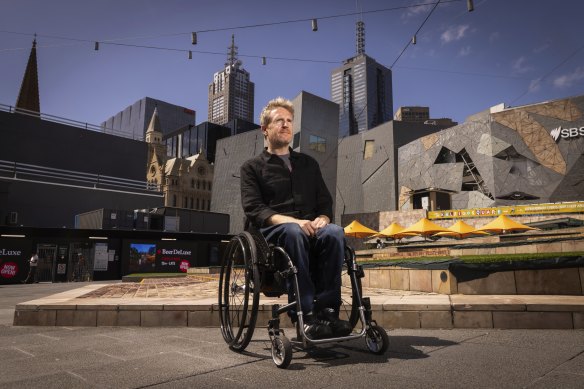
Ryan Smith says toilets, carparks, gradient and surface are the first things he considers when planning outings in the city.Credit: Paul Jeffers
“There’s a bit more consideration and it’s just toned back. The people around you are probably going to be more understanding too. It’s interesting – it’s not just autistic people who benefit from those sessions, for example sometimes wheelchair users will use them too because they know there’s going to be less people and they’re more likely to be able to see the art and move around freely.”
Read Ryan Smith’s reviews of Melbourne destinations and you’ll notice a lot of critiques of ground surfaces.
“I spend a lot of my time looking down … which is not the best way to see a city,” says Smith, the creator of Free Wheel Weekends, who is studying to be an inclusion consultant. “I basically created the sort of resource that I would use.”
He reviews Federation Square: “the incline and paving style are the main issues”, Camberwell market “a slow roll (read:incline) but great for a rummage and cheese toastie” and Mr Myagi (“long, sloped timber floor ... good amount of space in high traffic areas.”
Toilets, carparks, gradient and surface are the first things he considers when planning outings in the city.
“It’s not sexy and maybe that’s why it doesn’t get included in a lot of tourism, but it’s absolutely crucial for somebody like me to understand what to expect.”
Fed Square chief executive Caroline Ralphsmith said a bathroom designed for people who cannot use standard accessible toilets had recently been installed.
“We’re continually listening and learning from communities with the objective of Fed Square being a place for everyone,” she said.
A Tourism Research Australia report found 14 per cent of the Australian population (an estimated 3.4 million people) had need of accessible tourism experiences.
It said by 2050, nearly one quarter of the population would be aged 65 and over, with the growth in the ageing population and longer life expectancy leading to greater numbers of travellers who may need extra assistance.
Smith says any destination that isn’t accessible is missing out on a big chunk of the market.
He urges wheelchair users to “keep rolling”.
“Everytime we go to the supermarket or meet friends for a coffee, this is a moment to show people that we exist and we want to be included in society.”
The Morning Edition newsletter is our guide to the day’s most important and interesting stories, analysis and insights. Sign up here.